power steering fluid DODGE MAGNUM SRT 2007 1.G Owners Manual
[x] Cancel search | Manufacturer: DODGE, Model Year: 2007, Model line: MAGNUM SRT, Model: DODGE MAGNUM SRT 2007 1.GPages: 380, PDF Size: 6.63 MB
Page 60 of 380
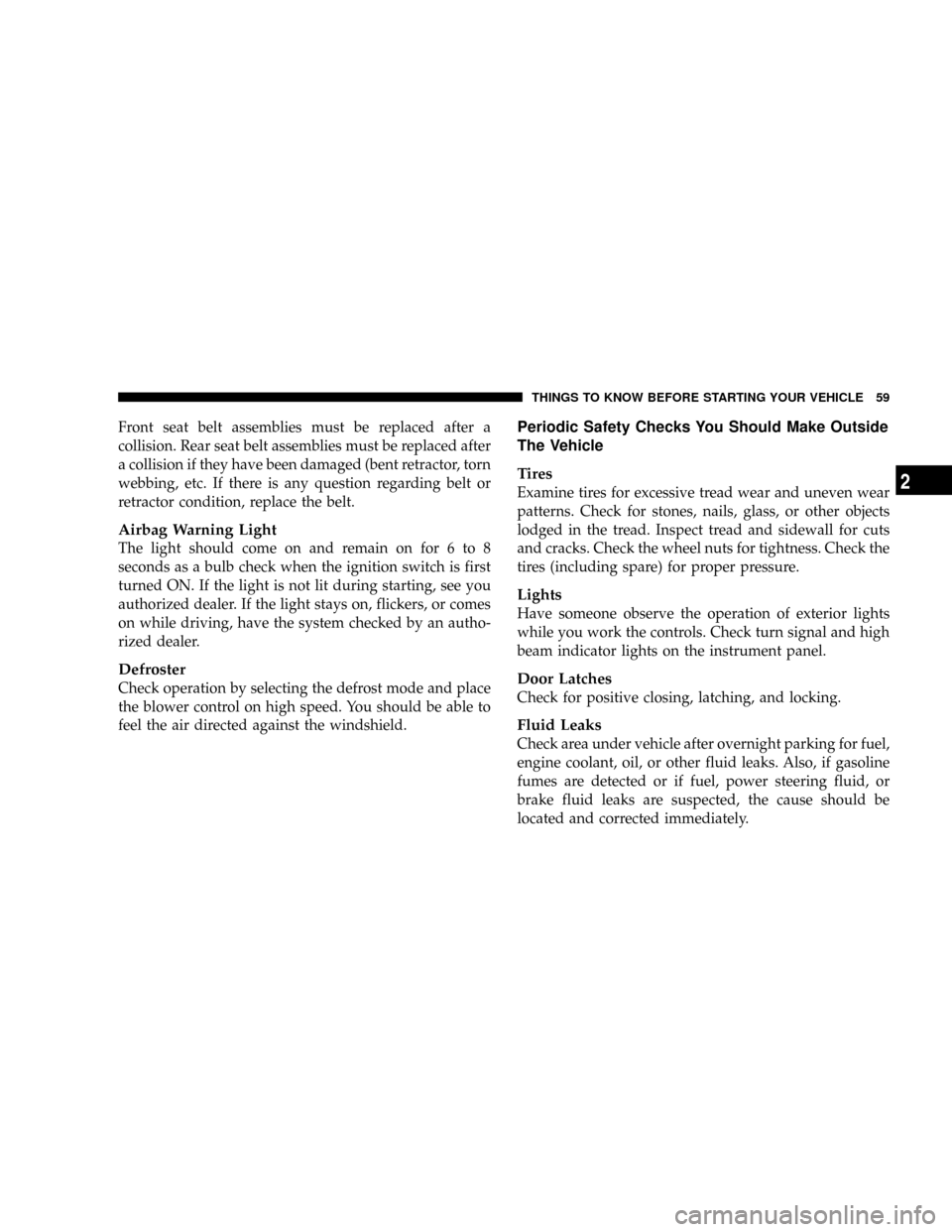
Front seat belt assemblies must be replaced after a
collision. Rear seat belt assemblies must be replaced after
a collision if they have been damaged (bent retractor, torn
webbing, etc. If there is any question regarding belt or
retractor condition, replace the belt.
Airbag Warning Light
The light should come on and remain on for 6 to 8
seconds as a bulb check when the ignition switch is first
turned ON. If the light is not lit during starting, see you
authorized dealer. If the light stays on, flickers, or comes
on while driving, have the system checked by an autho-
rized dealer.
Defroster
Check operation by selecting the defrost mode and place
the blower control on high speed. You should be able to
feel the air directed against the windshield.
Periodic Safety Checks You Should Make Outside
The Vehicle
Tires
Examine tires for excessive tread wear and uneven wear
patterns. Check for stones, nails, glass, or other objects
lodged in the tread. Inspect tread and sidewall for cuts
and cracks. Check the wheel nuts for tightness. Check the
tires (including spare) for proper pressure.
Lights
Have someone observe the operation of exterior lights
while you work the controls. Check turn signal and high
beam indicator lights on the instrument panel.
Door Latches
Check for positive closing, latching, and locking.
Fluid Leaks
Check area under vehicle after overnight parking for fuel,
engine coolant, oil, or other fluid leaks. Also, if gasoline
fumes are detected or if fuel, power steering fluid, or
brake fluid leaks are suspected, the cause should be
located and corrected immediately.
THINGS TO KNOW BEFORE STARTING YOUR VEHICLE 59
2
Page 222 of 380
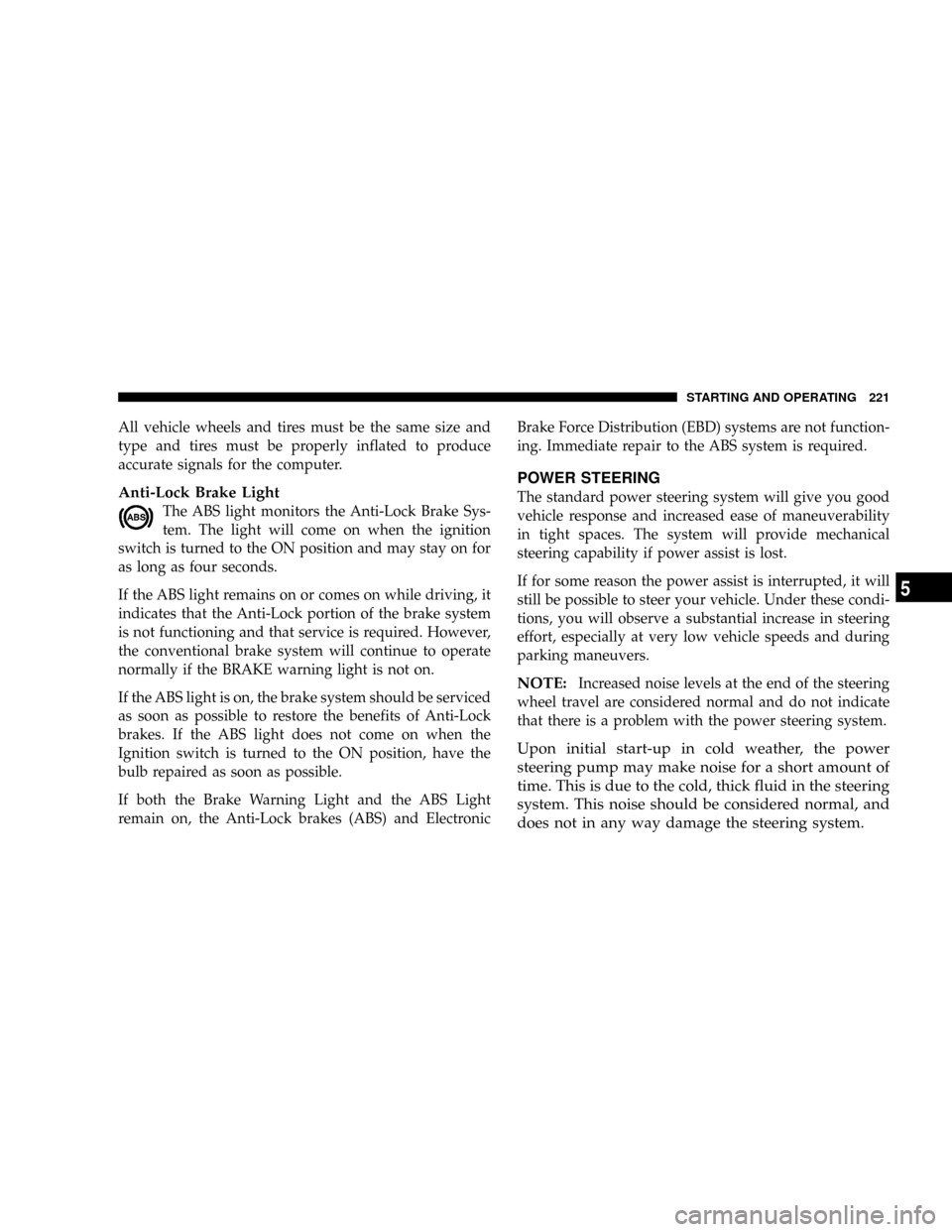
All vehicle wheels and tires must be the same size and
type and tires must be properly inflated to produce
accurate signals for the computer.
Anti-Lock Brake Light
The ABS light monitors the Anti-Lock Brake Sys-
tem. The light will come on when the ignition
switch is turned to the ON position and may stay on for
as long as four seconds.
If the ABS light remains on or comes on while driving, it
indicates that the Anti-Lock portion of the brake system
is not functioning and that service is required. However,
the conventional brake system will continue to operate
normally if the BRAKE warning light is not on.
If the ABS light is on, the brake system should be serviced
as soon as possible to restore the benefits of Anti-Lock
brakes. If the ABS light does not come on when the
Ignition switch is turned to the ON position, have the
bulb repaired as soon as possible.
If both the Brake Warning Light and the ABS Light
remain on, the Anti-Lock brakes (ABS) and ElectronicBrake Force Distribution (EBD) systems are not function-
ing. Immediate repair to the ABS system is required.
POWER STEERING
The standard power steering system will give you good
vehicle response and increased ease of maneuverability
in tight spaces. The system will provide mechanical
steering capability if power assist is lost.
If for some reason the power assist is interrupted, it will
still be possible to steer your vehicle. Under these condi-
tions, you will observe a substantial increase in steering
effort, especially at very low vehicle speeds and during
parking maneuvers.
NOTE:Increased noise levels at the end of the steering
wheel travel are considered normal and do not indicate
that there is a problem with the power steering system.
Upon initial start-up in cold weather, the power
steering pump may make noise for a short amount of
time. This is due to the cold, thick fluid in the steering
system. This noise should be considered normal, and
does not in any way damage the steering system.
STARTING AND OPERATING 221
5
Page 223 of 380
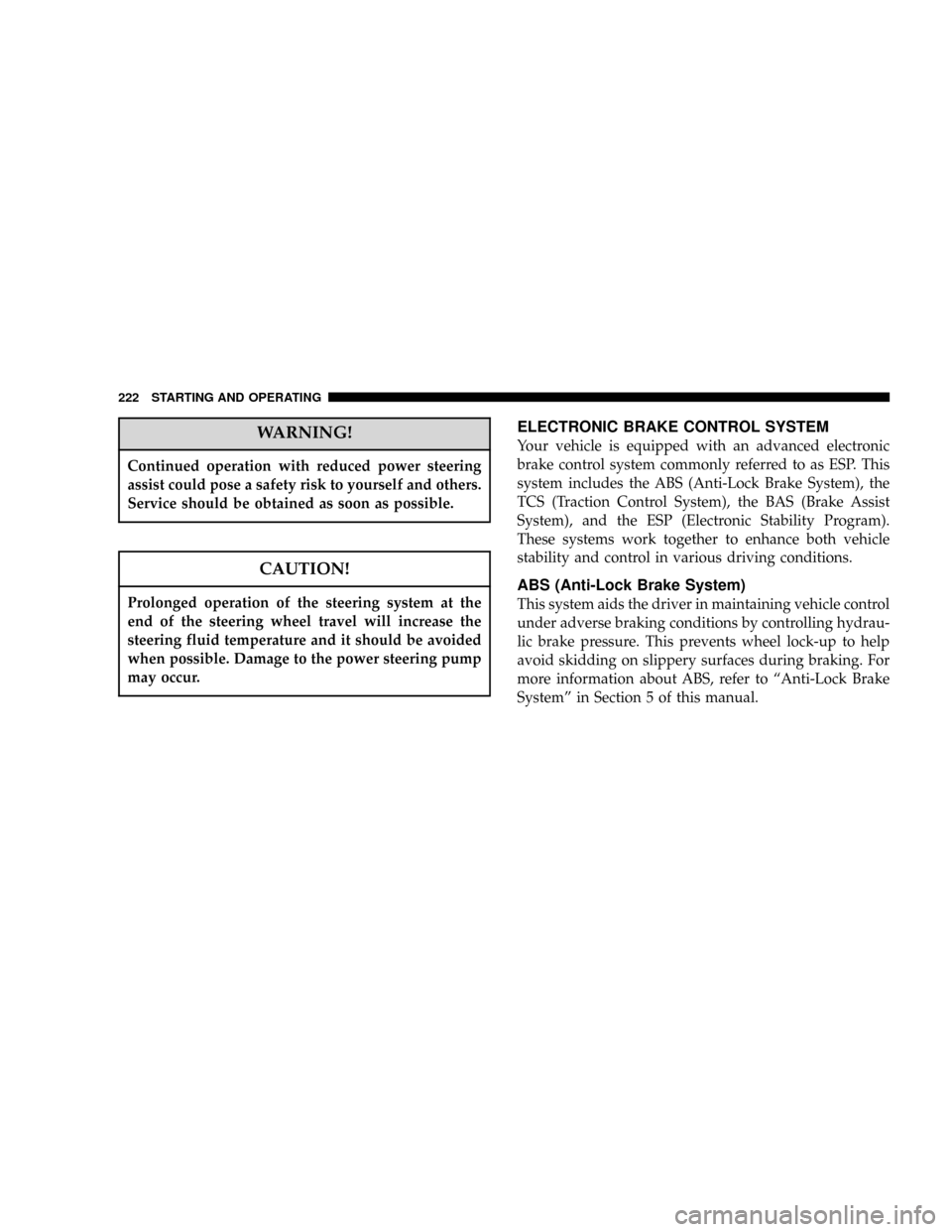
WARNING!
Continued operation with reduced power steering
assist could pose a safety risk to yourself and others.
Service should be obtained as soon as possible.
CAUTION!
Prolonged operation of the steering system at the
end of the steering wheel travel will increase the
steering fluid temperature and it should be avoided
when possible. Damage to the power steering pump
may occur.
ELECTRONIC BRAKE CONTROL SYSTEM
Your vehicle is equipped with an advanced electronic
brake control system commonly referred to as ESP. This
system includes the ABS (Anti-Lock Brake System), the
TCS (Traction Control System), the BAS (Brake Assist
System), and the ESP (Electronic Stability Program).
These systems work together to enhance both vehicle
stability and control in various driving conditions.
ABS (Anti-Lock Brake System)
This system aids the driver in maintaining vehicle control
under adverse braking conditions by controlling hydrau-
lic brake pressure. This prevents wheel lock-up to help
avoid skidding on slippery surfaces during braking. For
more information about ABS, refer to ªAnti-Lock Brake
Systemº in Section 5 of this manual.
222 STARTING AND OPERATING
Page 290 of 380

MAINTAINING YOUR VEHICLE
CONTENTS
m6.1L Engine Compartment...............291
mOnboard Diagnostic System Ð OBD II......292
NLoose Fuel Filler Cap..................292
mEmissions Inspection And Maintenance
Programs
............................293
mReplacement Parts.....................294
mDealer Service........................294
mMaintenance Procedures.................295
NEngine Oil..........................295
NEngine Oil Filter......................298
NDrive Belts Ð Check Condition And Tension . . 298
NSpark Plugs.........................298NEngine Air Cleaner Filter................299
NFuel Filter..........................299
NCatalytic Converter....................299
NMaintenance-Free Battery................301
NAir Conditioner Maintenance.............302
NA/C Air Filter Ð If Equipped............303
NPower Steering Ð Fluid Check............304
NFront & Rear Suspension Ball Joints........304
NSteering Linkage......................304
NBody Lubrication.....................304
NWiper Blades........................305
7
Page 305 of 380
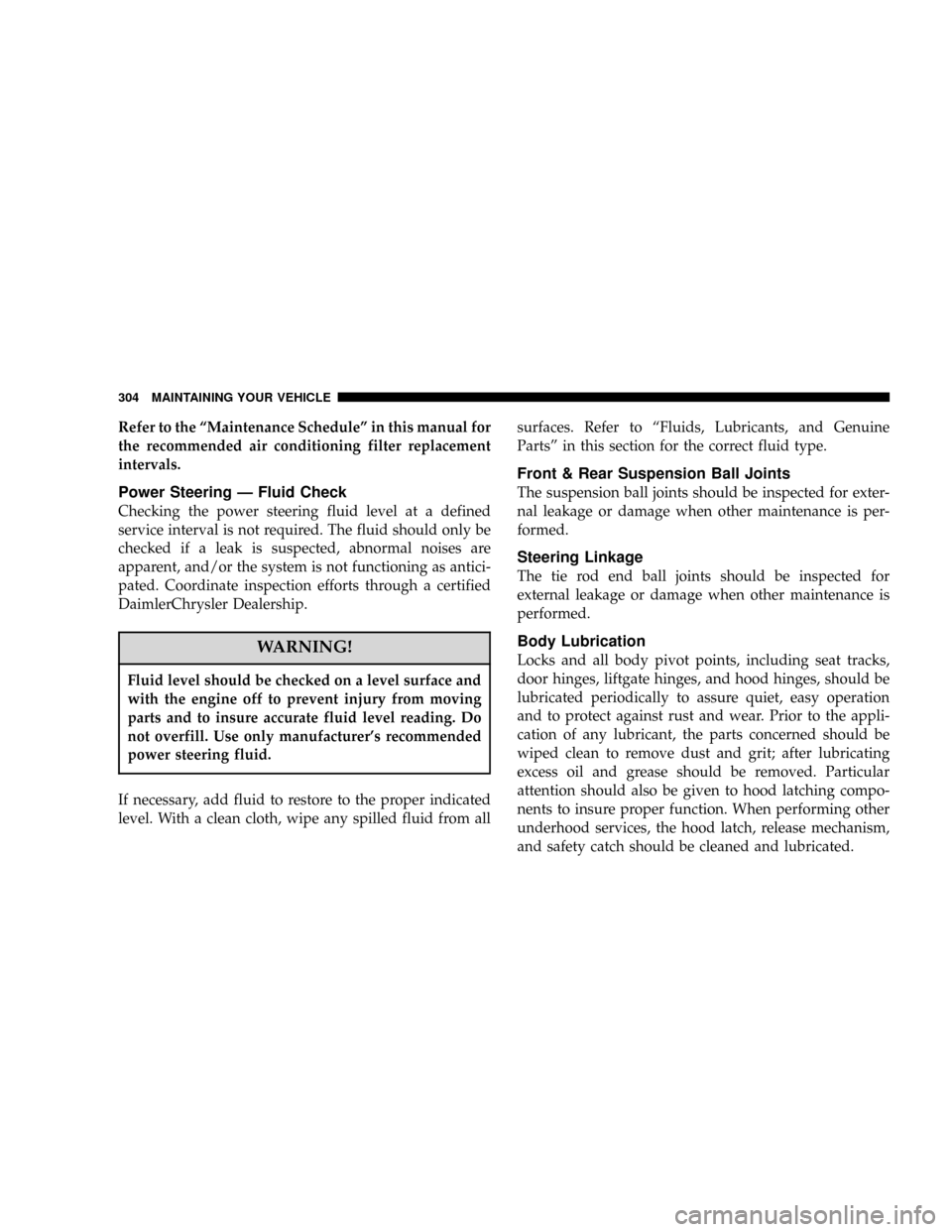
Refer to the ªMaintenance Scheduleº in this manual for
the recommended air conditioning filter replacement
intervals.
Power Steering Ð Fluid Check
Checking the power steering fluid level at a defined
service interval is not required. The fluid should only be
checked if a leak is suspected, abnormal noises are
apparent, and/or the system is not functioning as antici-
pated. Coordinate inspection efforts through a certified
DaimlerChrysler Dealership.
WARNING!
Fluid level should be checked on a level surface and
with the engine off to prevent injury from moving
parts and to insure accurate fluid level reading. Do
not overfill. Use only manufacturer's recommended
power steering fluid.
If necessary, add fluid to restore to the proper indicated
level. With a clean cloth, wipe any spilled fluid from allsurfaces. Refer to ªFluids, Lubricants, and Genuine
Partsº in this section for the correct fluid type.
Front & Rear Suspension Ball Joints
The suspension ball joints should be inspected for exter-
nal leakage or damage when other maintenance is per-
formed.
Steering Linkage
The tie rod end ball joints should be inspected for
external leakage or damage when other maintenance is
performed.
Body Lubrication
Locks and all body pivot points, including seat tracks,
door hinges, liftgate hinges, and hood hinges, should be
lubricated periodically to assure quiet, easy operation
and to protect against rust and wear. Prior to the appli-
cation of any lubricant, the parts concerned should be
wiped clean to remove dust and grit; after lubricating
excess oil and grease should be removed. Particular
attention should also be given to hood latching compo-
nents to insure proper function. When performing other
underhood services, the hood latch, release mechanism,
and safety catch should be cleaned and lubricated.
304 MAINTAINING YOUR VEHICLE
Page 314 of 380
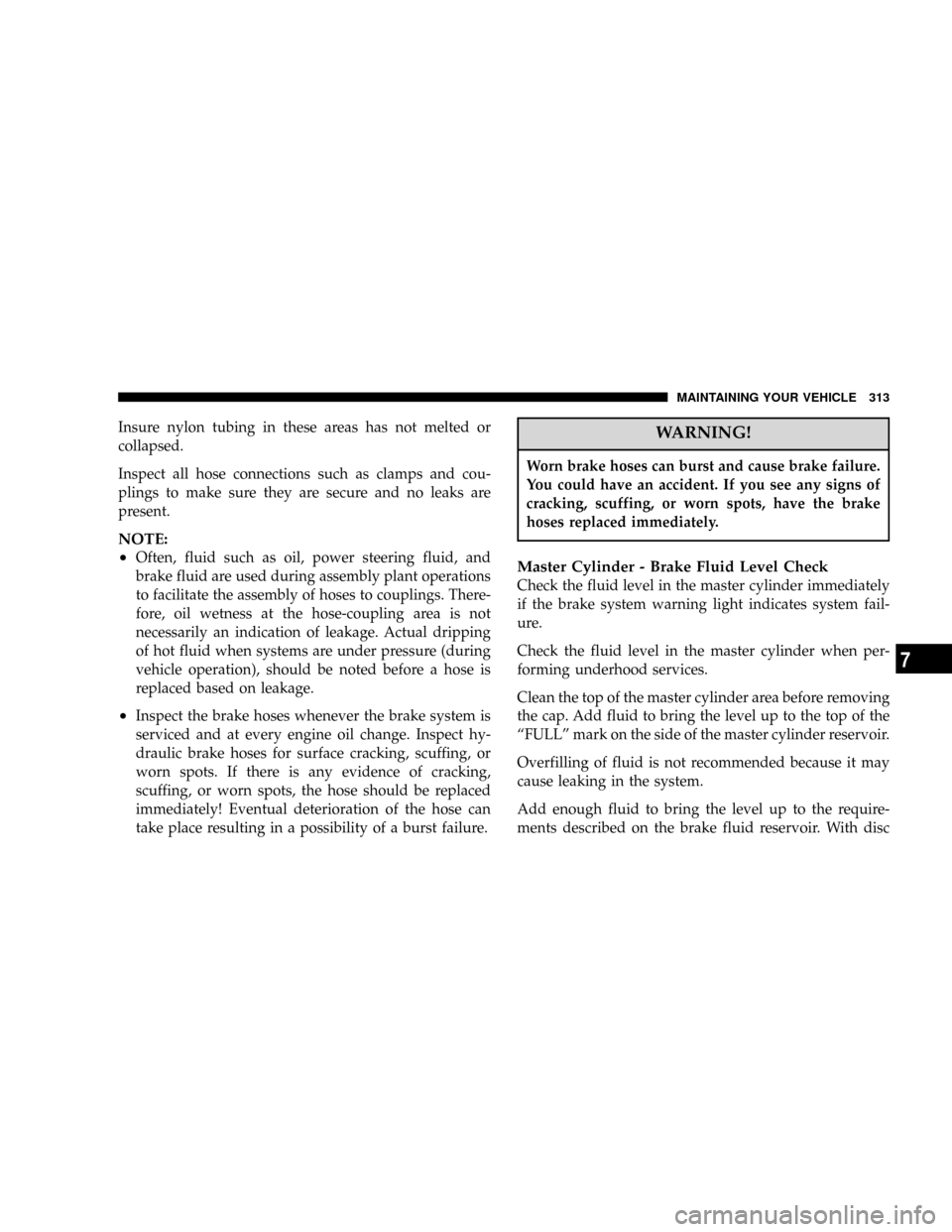
Insure nylon tubing in these areas has not melted or
collapsed.
Inspect all hose connections such as clamps and cou-
plings to make sure they are secure and no leaks are
present.
NOTE:
²
Often, fluid such as oil, power steering fluid, and
brake fluid are used during assembly plant operations
to facilitate the assembly of hoses to couplings. There-
fore, oil wetness at the hose-coupling area is not
necessarily an indication of leakage. Actual dripping
of hot fluid when systems are under pressure (during
vehicle operation), should be noted before a hose is
replaced based on leakage.
²Inspect the brake hoses whenever the brake system is
serviced and at every engine oil change. Inspect hy-
draulic brake hoses for surface cracking, scuffing, or
worn spots. If there is any evidence of cracking,
scuffing, or worn spots, the hose should be replaced
immediately! Eventual deterioration of the hose can
take place resulting in a possibility of a burst failure.
WARNING!
Worn brake hoses can burst and cause brake failure.
You could have an accident. If you see any signs of
cracking, scuffing, or worn spots, have the brake
hoses replaced immediately.
Master Cylinder - Brake Fluid Level Check
Check the fluid level in the master cylinder immediately
if the brake system warning light indicates system fail-
ure.
Check the fluid level in the master cylinder when per-
forming underhood services.
Clean the top of the master cylinder area before removing
the cap. Add fluid to bring the level up to the top of the
ªFULLº mark on the side of the master cylinder reservoir.
Overfilling of fluid is not recommended because it may
cause leaking in the system.
Add enough fluid to bring the level up to the require-
ments described on the brake fluid reservoir. With disc
MAINTAINING YOUR VEHICLE 313
7
Page 334 of 380
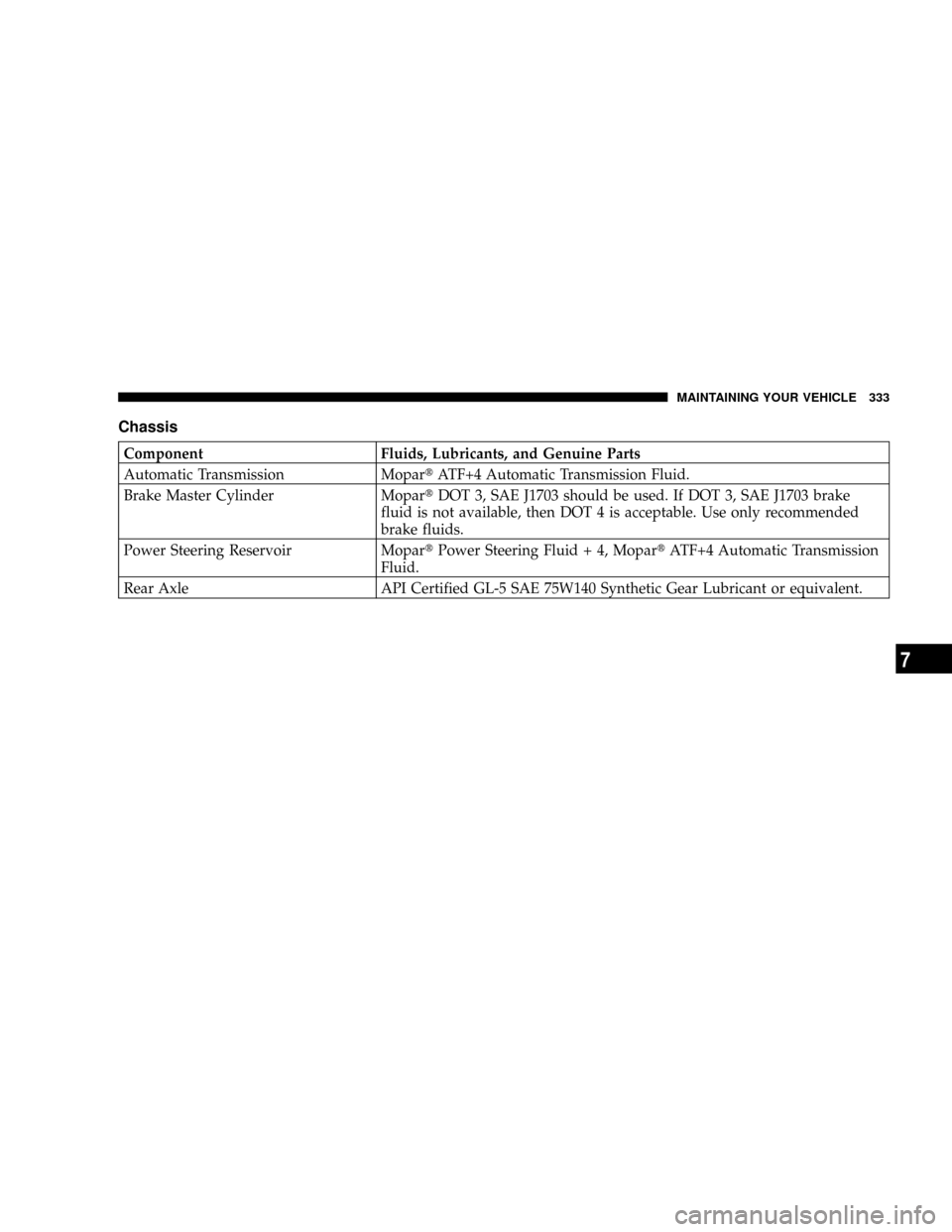
Chassis
Component Fluids, Lubricants, and Genuine Parts
Automatic Transmission MopartATF+4 Automatic Transmission Fluid.
Brake Master Cylinder MopartDOT 3, SAE J1703 should be used. If DOT 3, SAE J1703 brake
fluid is not available, then DOT 4 is acceptable. Use only recommended
brake fluids.
Power Steering Reservoir MopartPower Steering Fluid + 4, MopartATF+4 Automatic Transmission
Fluid.
Rear Axle API Certified GL-5 SAE 75W140 Synthetic Gear Lubricant or equivalent.
MAINTAINING YOUR VEHICLE 333
7
Page 344 of 380
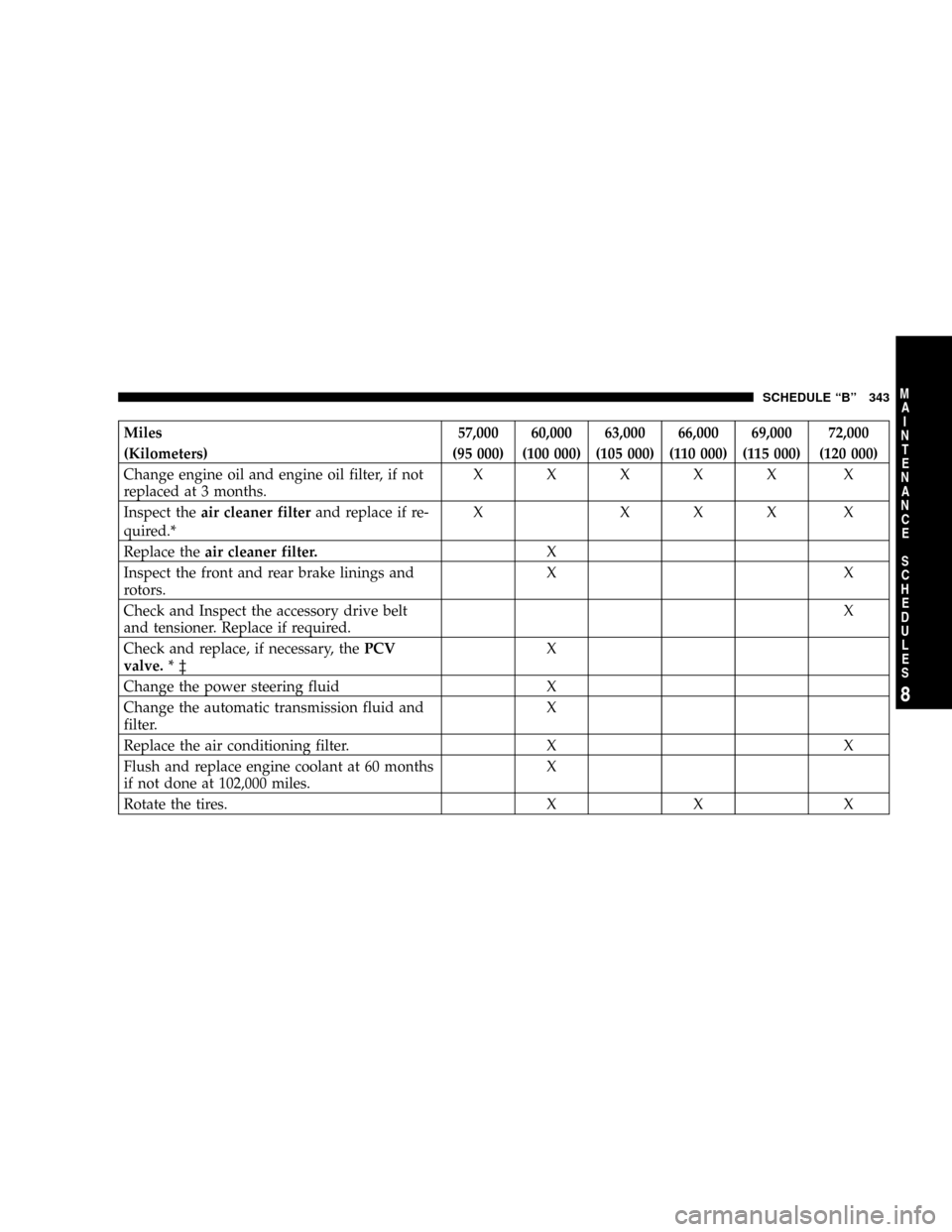
Miles 57,000 60,000 63,000 66,000 69,000 72,000
(Kilometers) (95 000) (100 000) (105 000) (110 000) (115 000) (120 000)
Change engine oil and engine oil filter, if not
replaced at 3 months.XXXXX X
Inspect theair cleaner filterand replace if re-
quired.*X XXX X
Replace theair cleaner filter.X
Inspect the front and rear brake linings and
rotors.XX
Check and Inspect the accessory drive belt
and tensioner. Replace if required.X
Check and replace, if necessary, thePCV
valve.*³X
Change the power steering fluid X
Change the automatic transmission fluid and
filter.X
Replace the air conditioning filter. X X
Flush and replace engine coolant at 60 months
if not done at 102,000 miles.X
Rotate the tires. X X X
SCHEDULE ªBº 343
8
M
A
I
N
T
E
N
A
N
C
E
S
C
H
E
D
U
L
E
S
Page 369 of 380
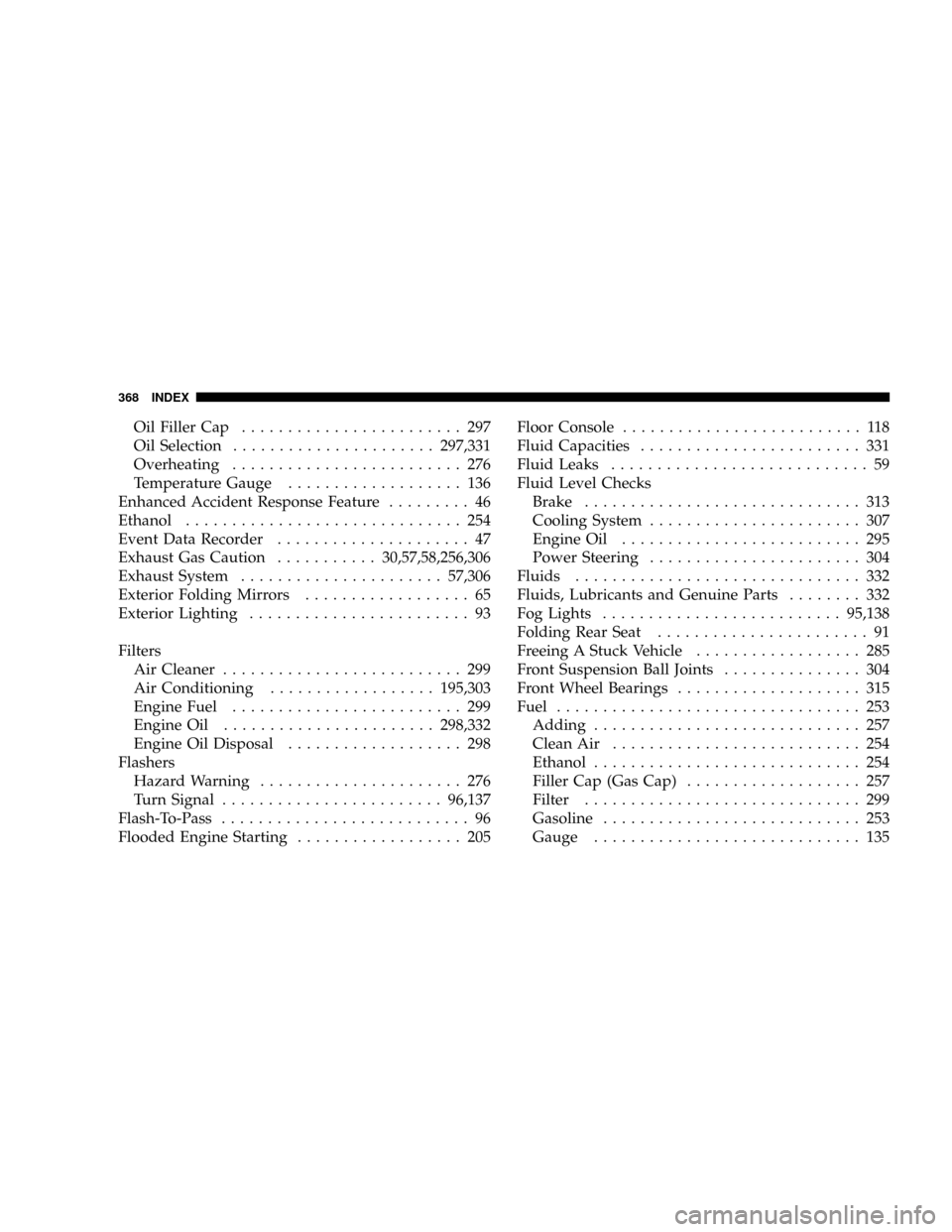
Oil Filler Cap........................ 297
Oil Selection......................297,331
Overheating......................... 276
Temperature Gauge................... 136
Enhanced Accident Response Feature......... 46
Ethanol.............................. 254
Event Data Recorder..................... 47
Exhaust Gas Caution...........30,57,58,256,306
Exhaust System......................57,306
Exterior Folding Mirrors.................. 65
Exterior Lighting........................ 93
Filters
Air Cleaner.......................... 299
Air Conditioning..................195,303
Engine Fuel......................... 299
Engine Oil.......................298,332
Engine Oil Disposal................... 298
Flashers
Hazard Warning...................... 276
Turn Signal........................96,137
Flash-To-Pass........................... 96
Flooded Engine Starting.................. 205Floor Console.......................... 118
Fluid Capacities........................ 331
Fluid Leaks............................ 59
Fluid Level Checks
Brake.............................. 313
Cooling System....................... 307
Engine Oil.......................... 295
Power Steering....................... 304
Fluids............................... 332
Fluids, Lubricants and Genuine Parts........ 332
Fog Lights..........................95,138
Folding Rear Seat....................... 91
Freeing A Stuck Vehicle.................. 285
Front Suspension Ball Joints............... 304
Front Wheel Bearings.................... 315
Fuel................................. 253
Adding............................. 257
Clean Air........................... 254
Ethanol............................. 254
Filler Cap (Gas Cap)................... 257
Filter.............................. 299
Gasoline............................ 253
Gauge............................. 135
368 INDEX